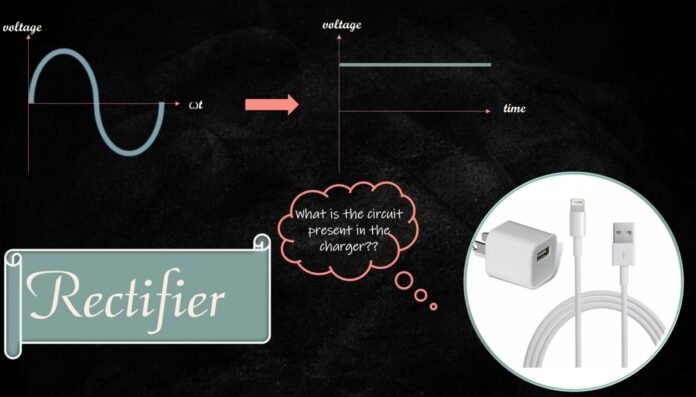Introduction
An electrical device known as a rectifier transforms AC (alternating current) into DC (direct current). The procedure is known as rectification because the current only flows in a single direction. Rectifiers are made up of P-N junction diodes that regulate the current’s direction so that it only flows in one direction. Half-wave rectifiers and full-wave rectifiers are the two varieties. You can find it in parts of DC motor supplies, electrical appliances, transformers, soldering irons, radios, gas heating systems, and the power supplies of radios, TVs, and computers. We go over rectifiers’ usage in this post.
Uses of Rectifier
The basic function of a rectifier is to transform AC power into DC electricity. Rectifiers are a common component of power sources for electronic equipment. Let’s look more closely at rectifiers’ use.
- Modulation
Information to be sent is contained in a modulated signal. Modulation is adding this signal to a carrier signal to vary its characteristics. A simple half-wave diode rectifier can be used to demodulate communications that have been modified by amplitude.
- Voltage Multiplier
An electrical circuit known as a voltage multiplier converts AC electrical power from a lower voltage to a higher DC voltage. A half-wave rectifier is used to create the voltage multiplier.
- Soldering
A half-wave rectifier is used in soldering iron-required circuits. An electrical connection is made by soldering metal pieces together. For electric welding, polarised bridge rectifier circuits deliver steady DC power.
- Circuits
In firing circuits, including pulse-producing circuits, a half-wave rectifier is utilised. Large appliances frequently use bridge rectifiers that convert high AC voltage to low DC voltage. Rectifiers are necessary for every charger circuit that transforms AC into DC.
- Transformers
We can pair step-down or step-up transformers with a half-wave rectifier to create the necessary DC voltage. If there are one or more circuits, a transformer would be a passive component that moves electrical energy across circuits. Transformers called step-up transformers are designed to boost the voltage from the primary to the secondary. Transformers called step-down transformers were designed to lower voltages across primary to secondary.
Applications of Rectifiers
A rectifier’s main function is to convert AC power into DC electricity. Within almost all-electronic equipment’s power supplies. Linear and switch mode power supplies make up the two DC–AC power supply categories. In such a power supply, the rectifier will be situated in series with the transformer and then filled with a voltage regulator or a smoothing filter. DC power conversion from one volt over another is substantially more difficult. DC-to-DC changes the transformer’s voltage by first converting power to AC. Then converts the power back to DC.
Rectifiers are utilised for the monitoring of amplitude-modulated radio transmissions. Before detection, the signal could get magnified. Rectifiers provide polarised voltage for welding applications; the output current is determined in these circuits. This is occasionally done by substituting thyristors and diodes to variable voltage output for the diode in a bridge rectifier.
Recommended Articles:
What is a Variable Star and Its Types
Value Of Plancks Constant
Value of g on the Moon
Value of C- Definition, Value and Measuring
Physics – Uses Of Solar Cooker
An electronic device called a rectifier uses one or more P-N junction diodes to exchange electricity into direct current. Diodes function as one-way valves that only let current flow in one direction. This action is referred to as the correction. The bridge rectifier, which utilises four diodes to aid in converting both half cycles of AC into DC output, is among the varieties of full-wave rectifiers. Full-bridge rectifiers have an extra branch compared to half-wave rectifiers, which enables them to transmit for the negative half of the voltage waveform. Thus, it can observe that the average voltage at the full-bridge rectifier's output would be twice as high as that of the half-bridge rectifier. These rectifiers fall under uncontrolled rectifiers because They cannot control their voltage output. To function properly, a rectifier needs a switch, and there are two sorts of switches: controlled and uncontrollable. A diode is defined as one that only operates in one way. You can not control the diode's operation; as long as it remains forward bias, it will continue to conduct current. Owing to this diode design, it is evident that the rectifier is not entirely under the user's control, thus the term "uncontrolled rectifiers." There are two primary types of rectifiers: full-wave and half-wave. Half-wave rectifiers only remove half the electrical output of an AC signal, leaving pulses of DC. Still, full-wave rectifiers convert a whole AC waveform into a sequence of single-polarity DC pulses. The most popular rectifiers for lower voltages and powers are silicon diodes, which have virtually displaced previous rectifiers. In low-voltage circuits, germanium diodes offer an inherent advantage over silicon diodes due to their significantly lower forward voltage (0.3V vs 0.7V for silicon diodes). Uses of Rectifier and their Applications FAQs
What is a rectifier, exactly?
How does a bridge rectifier operate, and what does it do?
What exactly are uncontrolled rectifiers, and what different kinds are there?
What are the types of rectifiers?
What rectifier is used most frequently, and why?
